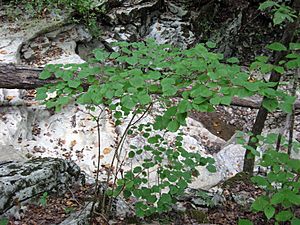Bracted arrowwood facts for kids
Quick facts for kids Bracted arrowwood |
|
|---|---|
 |
|
| Conservation status | |
| Scientific classification | |
| Genus: |
Viburnum
|
| Species: |
bracteatum
|
Viburnum bracteatum, also known as the bracted arrowwood or limerock arrowwood, is a special type of flowering plant. It's a deciduous shrub, which means it loses its leaves in the fall. This plant is native to the southeastern United States, mainly found in Alabama, Georgia, and Tennessee. It's quite rare, and scientists are working to protect it.
Contents
Discovering the Bracted Arrowwood
What Does It Look Like?
The bracted arrowwood is a shrub that can grow up to 3 meters (about 10 feet) tall. It has branches that spread out and arch gracefully. The bark on its stems is smooth and gray.
Its leaves grow in pairs, one across from the other. Each leaf can be up to 12 centimeters (about 5 inches) long. The edges of the leaves are toothed, like a tiny saw. These leaves sit on short stems called petioles.
In the spring, the plant produces beautiful white flowers. These flowers grow in clusters that are about 4 to 6 centimeters (about 2 inches) wide. Each flower has five white petals, forming a circle. They also have five stamens, which are tiny stalks with yellow tips.
After the flowers bloom, the plant grows small, round fruits. These fruits are a pretty bluish-black color and are about 1 centimeter (less than half an inch) wide. Many animals enjoy eating these fruits, including birds, small mammals, and deer.
Where Does It Grow?
The bracted arrowwood likes to grow in wooded areas. It has a special preference for places where the soil contains limestone. This type of rock helps the plant grow well.
In these forests, you might find other trees growing nearby. These often include different kinds of oak trees. You might also see Carya ovata, which is a type of hickory tree.
Why Is It Rare?
This plant is quite rare. Scientists have found only about eleven groups of these plants in the wild. Sadly, only five of these groups are considered strong enough to survive for a long time.
One of the biggest threats to the bracted arrowwood is limestone mining. This activity involves digging up limestone from the ground. When mining happens, it can destroy or damage the places where these special plants live. Protecting these areas is important to help the bracted arrowwood survive.


